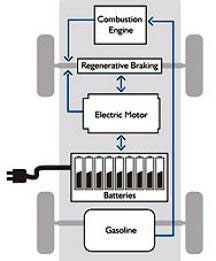"Anything You Can Do, I Can Do Better..."
 In this section, we will give you a brief outline of the similarities and differences between hybrid and electric vehicles. This includes a discussion of hybrid components such as the power-split device as well as mention of the relatively-new innovation: the plug-in hybrid electric vehicle.
In this section, we will give you a brief outline of the similarities and differences between hybrid and electric vehicles. This includes a discussion of hybrid components such as the power-split device as well as mention of the relatively-new innovation: the plug-in hybrid electric vehicle.
A significant problem with the current electric vehicle is its energy density. The Rocky Mountain Institute states that the present-day electric vehicle holds only about one one-hundreth of the energy per kilogram compared to gasoline [6]. Although the electric vehicle does completely eliminate the dependence on fossil fuels, there still remains the issue of producing the additional electricity, much of which is done at coal-fueled power plants.
Power-Split Devices
A power-split device is unique to the hybrid vehicle and is key to the hybrid's success as an alternative transportation vehicle [5]. It works much like its name suggests. It allows for an engine to split its power so that it can use its energy to do two things at once, namely: 1) propel the vehicle; and 2) charge the battery [5]. This is a useful device in a hybrid vehicle since it allows for the battery to be charged without consuming electricity from a power grid. Additionally, it allows for the electric motor and engine to either work separately or together to propel the vehicle.
In case you missed it earlier, there is a power-split device shown explicitly in the full hybrid section of the following Flash demo [5]: Flash Animation: How Hybrids Work
An electric vehicle has only one source of energy, namely the battery. So far, the energy density of these batteries is quite low, which means that you need to carry around more weight to do the same amount of work as, say, a gasoline-powered vehicle [6]. This compounds the problem, since the electric vehicle must be heavier and, therefore, more difficult to accelerate [6]. The hybrid solves these problems by relying on part of its energy from gasoline, while at the same time ensuring that its energy is being used in the most efficient way possible. This is due largely to the power-split device.
Plug-in Hybrid Electric Vehicles
|
A plug-in hybrid electric vehicle works using many of the same principles as the ordinary hybrid vehicles discussed previously. The main difference is that it aims to provide 'the best of both worlds' by incorporating into the design the plug-in charging technology used in electric vehicles. For a schematic diagram of a plug-in hybrid vehicle, see below (diagram reproduced with permission from the Electric Drive Transportation Association): |
|
|
|
To be fair, we should mention that this type of vehicle is still very much in the development stages and is not yet ready for commercial use [7]. However, it offers the opportunity of amalgamating the electric and hybrid vehicles. It will allow for three separate energy sources: the gasoline-fueled engine, the regenerative energy from braking and excess engine power, and pure electrical energy from the power grid [7]. |
To finish up our study of hybrids, we should really take a quick look at some data on various makes and models of hybrid vehicles in order to see which ones really do perform the best. See our hybrid vehicle comparison by following this link.
